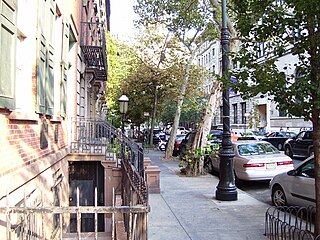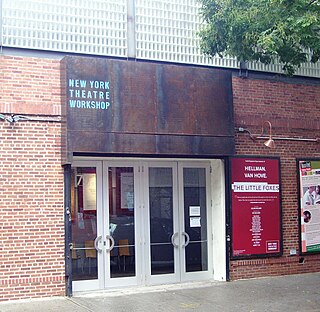
Greenwich Village, often referred to by locals as simply "the Village", is a neighborhood on the west side of Manhattan, New York City, within Lower Manhattan. Broadly, Greenwich Village is bounded by 14th Street to the north, Broadway to the east, Houston Street to the south, and the Hudson River to the west. Greenwich Village also contains several subsections, including the West Village west of Seventh Avenue and the Meatpacking District in the northwest corner of Greenwich Village.

SoHo, sometimes written Soho, is a neighborhood in Lower Manhattan, New York City, which in recent history came to the public's attention for being the location of many artists' lofts and art galleries, but is now better known for its variety of shops ranging from trendy upscale boutiques to national and international chain store outlets. The area's history is an archetypal example of inner-city regeneration and gentrification, encompassing socioeconomic, cultural, political, and architectural developments.

Manhattan's Chinatown is a neighborhood in Lower Manhattan, New York City, bordering the Lower East Side to its east, Little Italy to its north, Civic Center to its south, and Tribeca to its west. With an estimated population of 90,000 to 100,000 people, Chinatown is home to the highest concentration of Chinese people in the Western Hemisphere. Manhattan's Chinatown is also one of the oldest Chinese ethnic enclaves. The Manhattan Chinatown is one of nine Chinatown neighborhoods in New York City, as well as one of twelve in the New York metropolitan area, which contains the largest ethnic Chinese population outside of Asia, comprising an estimated 893,697 uniracial individuals as of 2017.

Chelsea is a neighborhood on the West Side of the borough of Manhattan in New York City. The district's boundaries are roughly 14th Street to the south, the Hudson River and West Street to the west, and Sixth Avenue to the east, with its northern boundary variously described as near the upper 20s or 34th Street, the next major crosstown street to the north. To the northwest of Chelsea is the neighborhood of Hell's Kitchen, as well as Hudson Yards; to the northeast are the Garment District and the remainder of Midtown South; to the east are NoMad and the Flatiron District; to the southwest is the Meatpacking District; and to the south and southeast are the West Village and the remainder of Greenwich Village. Chelsea is named after the Royal Hospital Chelsea in London, England.

Alphabet City is a neighborhood located within the East Village in the New York City borough of Manhattan. Its name comes from Avenues A, B, C, and D, the only avenues in Manhattan to have single-letter names. It is bordered by Houston Street to the south and by 14th Street to the north, along the traditional northern border of the East Village and south of Stuyvesant Town and Peter Cooper Village. Some famous landmarks include Tompkins Square Park and the Nuyorican Poets Cafe.

NoHo, for North of Houston Street is a landmarked, primarily residential upper-class neighborhood in the New York City borough of Manhattan. It is bounded by Mercer Street to the west and the Bowery to the east, and from East 9th Street in the north to East Houston Street in the south.

The East Village is a neighborhood on the East Side of Manhattan, New York City, within Lower Manhattan. It is roughly defined as the area east of the Bowery and Third Avenue, between 14th Street on the north and Houston Street on the south. The East Village contains three subsections: Alphabet City, in reference to the single-letter-named avenues that are located to the east of First Avenue; Little Ukraine, near Second Avenue and 6th and 7th Streets; and Bowery, located around the street of the same name.

The Upper West Side, sometimes abbreviated UWS, is a neighborhood in the borough of Manhattan, New York City, bounded by Central Park and the Hudson River, and West 59th Street and West 110th Street.

The Lower East Side, sometimes abbreviated as LES, is a neighborhood in the southeastern part of the New York City borough of Manhattan, roughly located between the Bowery and the East River from Canal to Houston Streets. Traditionally an immigrant, working class neighborhood, it began rapid gentrification in the mid-2000s, prompting the National Trust for Historic Preservation to place the neighborhood on their list of America's Most Endangered Places.

Union Square is a historic intersection and surrounding neighborhood in Manhattan, New York City, located where Broadway and the former Bowery Road – now Fourth Avenue – came together in the early 19th century. Its name denotes that "here was the union of the two principal thoroughfares of the island". The current Union Square Park is bounded by 14th Street on the south, 17th Street on the north, and Union Square West and Union Square East to the west and east respectively. 17th Street links together Broadway and Park Avenue South on the north end of the park, while Union Square East connects Park Avenue South to Fourth Avenue and the continuation of Broadway on the park's south side. The park is under the aegis of the New York City Department of Parks and Recreation.

The Bowery is a street and neighborhood in the southern portion of the New York City borough of Manhattan. The street runs from Chatham Square at Park Row, Worth Street, and Mott Street in the south to Cooper Square at 4th Street in the north. The eponymous neighborhood runs roughly from the Bowery east to Allen Street and First Avenue, and from Canal Street north to Cooper Square/East Fourth Street. To the south is Chinatown, to the east are the Lower East Side and the East Village, and to the west are Little Italy and NoHo. It has historically been considered a part of the Lower East Side.

Stuyvesant Street is one of the oldest streets in the New York City borough of Manhattan. It runs diagonally from 9th Street at Third Avenue to 10th Street near Second Avenue, all within the East Village, Manhattan neighborhood. The majority of the street is included in the St. Mark's Historic District.

New York Theatre Workshop (NYTW) is an Off-Broadway theatre noted for its productions of new works. Located at 79 East 4th Street between Second Avenue and Bowery in the East Village neighborhood of Manhattan, New York City, it houses a 198-seat theatre for its mainstage productions, and a 75-seat black box theatre for staged readings and developing work in the building next door, at 83 East 4th Street.

Manhattanville is a neighborhood in the New York City borough of Manhattan bordered on the north by 135th Street; on the south by 122nd and 125th Streets; on the west by Hudson River; and on the east by Adam Clayton Powell Jr. Boulevard and the campus of City College.

The West Village is a neighborhood in the western section of the larger Greenwich Village neighborhood of Lower Manhattan, New York City.
Dixon Place is a theater organization located in New York City dedicated to the development of works-in-progress from a broad range of performers and artists. It exists to serve the creative needs of artists—emerging, mid-career and established—who are creating new work in theater, dance, music, literature, puppetry, performance, variety and visual arts.

The Joyce Theater is a 472-seat dance performance venue located in the Chelsea neighborhood of New York City. The building opened in 1941 as the Elgin Theater, a movie house, and was gut-renovated and reconfigured in 1981-82 to reopen as the Joyce Theater. The Joyce is a leading presenter of dance in New York City and nationally.

The Greenwich Village Society for Historic Preservation (GVSHP) is a non-profit membership organization that documents, honors and preserves the architectural heritage and cultural history of several neighborhoods in Lower Manhattan, New York City: Greenwich Village, the Far West Village, the Meatpacking District, the South Village, NoHo, and the East Village. In 2019, it was rebranded, but not renamed, as Village Preservation.
The Clemente Soto Velez Cultural and Educational Center, often called The Clemente, is a Puerto Rican/Latino cultural center named after Puerto Rican writer and activist, Clemente Soto Vélez. The Center, which was formed in 1993, is located on Suffolk Street in the former PS 160 in Manhattan's historic Lower East Side neighborhood of Loisaida.

The Faison Firehouse Theater is a theater in Harlem, New York founded in 1999 by Tony award winning choreographer George Faison and Tad Schnugg. It is operated by the American Performing Arts Collaborative (APAC), a not-for-profit (501c3) founded in 1997.

















